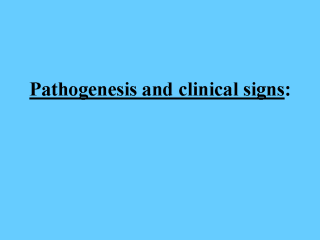| front |1 |2 |3 |4 |5 |6 |7 |8 |9 |10 |11 |12 |13 |14 |15 |16 |17 |18 |19 |review |
 |
- ICHV infects
and replicates in the oropharynx after the ingestion of infective material from faeces,
urine or respiratory secretions. A viraemia follows and the virus reaches the endothelial
cells of the liver and kidney which are its target organs by 3 days. Severe abdominal pain
often followed by death. - With older dogs or avirulent isolates the disease may be milder with enlargement of the tonsils, submaxillary lymph nodes and sometimes immune complex keratitis (see later). Recovered animals sometimes continue to excrete virus from the renal tubules into the urine for several years despite having circulating neutralising antibodies. These immune complexes result in chronic interstitial nephritis. - At post mortem there is a haemorrhagic swollen liver, ascites and oedema of the gall bladder wall. Areas containing intranuclear inclusion bodies and necrotic cells occur in the hepatic parenchyma and sinusoids and renal tubules.
|